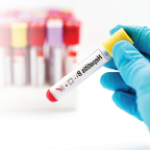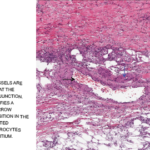Comparison with earlier CT angiography plates did show presence of new aneurysms, and because a past history of near-fatal aneurysmal rupture existed, after an adequate explanation to the patient, a decision was taken to treat him as active disease. Because the viral serologies were negative, cyclophosphamide and steroids were instituted.9
The other important aspect of this case was to assess disease activity. ESR/CRP was normal, and the patient could not afford a positron emission tomography/magnetic resonance angiography (PET/MR), which can help assess disease activity. Thus, after three doses of intravenous cyclophosphamide, a repeat CT angiography was performed, which showed significant reduction in the size and number of aneurysms.
This highlights the difficulty of monitoring response to treatment in the face of normal inflammatory markers and the role of imaging in monitoring disease activity in patients with polyarteritis nodosa.

Dr. Parikh

Dr. Yathish

Dr. Sagdeo
Taral Parikh, MD, G.C. Yathish, MD, and Parikshit Sagdeo, MD, are rheumatology DNB students at Hinduja Hospital in Mumbai, India.

Dr. Canchi
Balakrishnan Canchi, MD, is chief of rheumatology at Hinduja Hospital.

Dr. Mangat
Gurmeet Mangat, MD, is a consultant rheumatologist at Hinduja Hospital.
Key Points
- Renal artery involvement in PAN is in the form of intra-renal aneurysms, differentiating it from other mimics.
- Assessing disease activity of such patients may be difficult.
- Consider such aneurysms as evidence of active disease, and treat them accordingly.
- Repeat imaging in such patients could show a reduction in the aneurysms’ size, number or both.
References
- Jennette JC, Falk RJ, Bacon PA, et al. 2012 revised International Chapel Hill Consensus Conference Nomenclature of Vasculitides. Arthritis Rheum. 2013 Jan;65(1):1–11.
- Hunder GG, Arend WP, Bloch DA, et al. The American College of Rheumatology 1990 criteria for the classification of vasculitis. Introduction. Arthritis Rheum. 1990 Aug;33(8):1065–1067.
- Henegar C, Pagnoux C, Puéchal X, et al. A paradigm of diagnostic criteria for polyarteritis nodosa: Analysis of a series of 949 patients with vasculitides. Arthritis Rheum. 2008 May;58(5):1528–1538.
- Kerr GS, Hallahan CW, Giordano J, et al. Takayasu arteritis. Ann Intern Med. 1994 Jun 1;120(11):919–929.
- Slavin RE. Segmental arterial mediolysis: Course, sequelae, prognosis, and pathologic- radiologic correlation, Cardiovasc Pathol. 2009 Nov–Dec;18(6):352–360.
- Hekali P, Kajander H, Pajari R, et al. Diagnostic significance of angiographically observed visceral aneurysms with regard to polyarteritis nodosa. Acta Radiol. 1991 Mar;32(2):143–148.
- Ozaki K, Miyayama S, Ushiogi Y, et al. Renal involvement of polyarteritis nodosa: CT and MR findings. Abdom Imaging. 2009 Mar–Apr;34(2):265–270.
- Pagnoux C, Seror R, Henegar C, et al. Clinical features and outcomes in 348 patients with polyarteritis nodosa: A systematic retrospective study of patients diagnosed between 1963 and 2005 and entered into the French Vasculitis Study Group Database. Arthritis Rheum. 2010 Feb;62(2):616–626.
- de Menthon M, Mahr A. Treating polyarteritis nodosa: Current state of the art. Clin Exp Rheumatol. 2011 Jan–Feb;29(1 Suppl 64):S110–S116.


